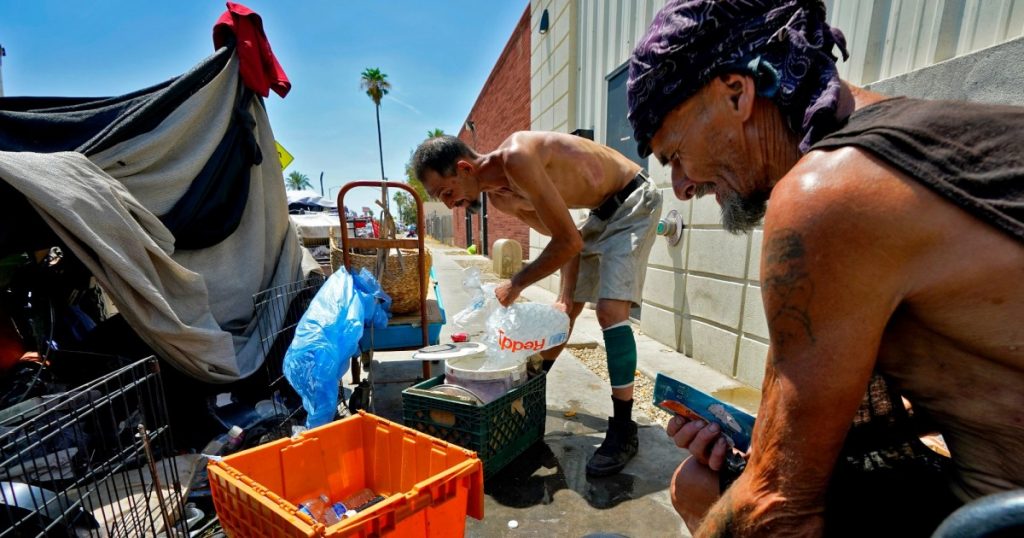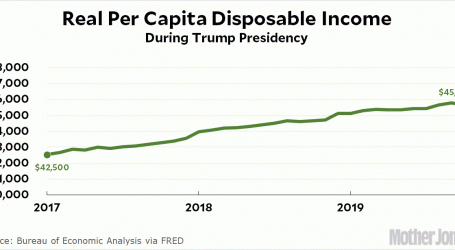Phoenix Just Had Its Hottest July Ever. So What Now?
Charles Sanders, 59, right, pauses as Kevin Hendershot, 47, pours ice into a bucket outside their tent in “The Zone” homeless encampment in downtown Phoenix during historic 2023 heatwave.Matt York/AP
This story was originally published by the Inside Climate News and is reproduced here as part of the Climate Desk collaboration.
That Phoenix is hot should come as no surprise. The heat is often the first thing that comes up when someone from out of state asks locals about living in the Valley of the Sun.
“How can you survive those summers?”
The response is always the same: “It’s a dry heat.”
But those dry summer heats are getting worse because of two factors: climate change and the sprawling development of the Valley. Neither is stopping anytime soon.
The consequences are now making headlines around the world, with Phoenix reaching 31 straight days of temperatures 110 degrees Fahrenheit or higher—a new record. The city also recorded its highest low temperature last week, a not-so-comfortable 97 degrees.
It’s not just Phoenix undergoing record-breaking temperatures, as other areas in North America, Asia, and Europe reached 110 degrees in recent weeks. June was the hottest month ever, until July came along, and scientists say this summer’s heatwave would be “almost impossible” without greenhouse gas emissions from humans.
So far this year in Phoenix, authorities have attributed 18 deaths to the heat and are investigating 69 more as possibly heat related, according to the Maricopa County Department of Public Health. Last year, the county had 29 confirmed deaths total, and 193 others are still under investigation. The city’s homeless population and low-income communities are the most vulnerable to the heat’s greatest threats, according to the city’s heat mitigation officer.
“It is a time for maximum community vigilance,” said David Hondula, the director of Phoenix’s Office of Heat Response and Mitigation. With each degree the temperature increases, he said, the public health risk grows. And with each day seemingly bringing another record-breaking temperature, residents are getting no breaks. Local and state leaders alike are pushing for heat waves like the one the Southwest is currently seeing to be listed as disasters by the Federal Emergency Management Agency to help communities coordinate responses to the events.
Unlike some other US metropolises, Phoenix, its suburbs and other Southwestern cities, was largely developed post-World War II, when single-family homes, automobiles, freeway systems and air conditioning had taken hold of American life. The Valley developed with those features in mind, leading to what some call “unrelenting sprawl.”
More roads encouraged driving and the burning of fossil fuels. The A/C systems that make life more livable here require more energy—usually also from fossil fuels—as the region heats up, and those systems also emit heat outside while keeping buildings cool. The sprawling development of asphalt roads and homes stretches out for miles and then retains heat overnight. Over the last 60 years at Phoenix’s Sky Harbor International Airport, nighttime temperatures in the summer have risen by almost 9 degrees Fahrenheit while daytime temperatures have risen by around two to three degrees.
“We continue to urbanize and develop and grow our cities, so that means that we introduce more and more impervious surfaces,” said Ariane Middel, an associate professor at Arizona State University who researches urban climate and extreme heat. “We build more roads, more parking lots and those are heat sponges. So they get hit by the sun during the day, they store the heat and then at night, once the sun sets, they release the heat back into the atmosphere. So that means that it’s not going to cool down as much in Phoenix as it used to.”
Record-breaking heat is nothing new in Phoenix, and, for years, people have been working to find solutions to mitigate it, including Middel who directs the SHaDE Lab at ASU.
One of the easiest ways to mitigate heat is to provide more shade in areas that need it, often by planting more trees, said Middel and other urban design and heat mitigation researchers. That idea is beginning to take root throughout the Phoenix metro area.
Aimee Esposito was born and raised in Arizona. As a child, she remembers the cooler temperatures of the less developed area she grew up in compared to the more industrial part of the city she lives in now. Helping to bring back open spaces and mitigate the heat has been her full-time job for nearly a decade at the local nonprofit Trees Matter. As executive director, her work is dedicated to increasing the shade canopy coverage in the Valley, and she helps residents, local utilities and municipalities plant more trees and educate the public on their importance.
Over the years, as the impact of climate change has grown more noticeable, she’s seen increasing political interest in planting more trees and providing more shade for residents across the Valley. Phoenix, Tempe, and Mesa have all implemented plans to increase shade canopy coverage. For example, Phoenix has the goal of covering 25 percent of the city with a canopy of trees by 2030, and has implemented a cool corridor program where it will be planting 200 trees per mile for a total of 1,800 new trees in areas selected based on neighborhood heat vulnerability, transit dependency, pedestrian use and current shade coverage.
“Phoenix is not just a desert, but in many areas of the city, it’s a shade desert,” Middel said.
That shade isn’t distributed equitably. Throughout Phoenix and other Valley cities, more-affluent communities have robust canopy coverage from trees, while lower-income and marginalized communities don’t, resulting in them experiencing more heat.
“It doesn’t help if you plant trees in the middle of nowhere and hope that they cool the air,” Middel said. “The trees need to go where the people are.”
More trees can have a lot of benefits, but growing them isn’t easy. The most important work Trees Matter does is educate residents about how to plant and take care of the trees, Esposito said. If they aren’t planted correctly, or when it’s too hot, or aren’t watered enough when they are young, they often die.
But investments in their care pay off in ways that other additions to the cityscape don’t. “A tree is a piece of infrastructure that grows in value as it gets bigger and older,” she said.
The shade trees provide can go further than just cooling down communities. They can help restore the groundwater aquifers beneath Phoenix, which are tapped out, and if placed to shade buildings from the sun can help lower energy bills for cooling.
Trees are not the only solution to the Valley’s heat problems.
Phoenix is experimenting with ASU researchers on a cool pavement program, intended to help surfaces reflect away solar radiation rather than absorbing that heat.
Like any solution, it’s not perfect. People walking along the surface in the reflected sunlight can potentially feel hotter. Like adding trees and their shade, researchers found that cool pavement must be placed strategically, like in places where there is little pedestrian traffic, to be effective at cooling the city.
“There’s not a single solution that we’re investigating—it’s a suite of solutions,” said David Sailor, a professor and director of ASU’s School of Geographical Sciences and Urban Planning. “And virtually every solution has pros and cons to it. So our goal is to better understand how these solutions work individually… and identify ways that we can make the solutions work better.”
One of the most obvious solutions would be to have fewer dark roofs and more that are more reflective. “I still see many black rooftops in Phoenix,” said Sailor, who is also the project director for the Southwest Urban Corridor Integrated Laboratory, a research project that received $25 million from the Department of Energy to investigate extreme heat in urban areas in the Southwest and find solutions for them. “Those rooftops are absorbing 95 percent of the energy from the sun and they get extremely hot.”
But perhaps more important than any potential mitigation, Sailor and Middel said, is policy shifts in how cities in the Phoenix metro area develop.
“The only way you can really get rid of that heat is to get rid of those surfaces [that absorb heat],” Middel said. “So if we can implement policies that reduce the minimum required surface for parking or the minimum number of parking lots…I think those are steps in the right direction to take out some of these heat sponge surfaces.”
Policies like that can be divisive, Sailor noted, but they can provide some big economic benefits as well and help solve other problems. Shaving half a degree of the temperatures in the summer across Phoenix could potentially save 22 billion gallons of the water the city is looking to conserve as it faces the consequences of drought along the Colorado River and overuse of groundwater. That half-degree difference can potentially save tens of millions of dollars in air conditioning costs, he said.
Policy shifts in city planning and a push to implement more heat-mitigating solutions like planting more trees can help make Phoenix and its residents adapt to the city’s rising temperatures.
“There’s no reason we can’t have a Phoenix of the future that’s more comfortable than the one we have today,” said Hondula, the city’s heat mitigation officer.




